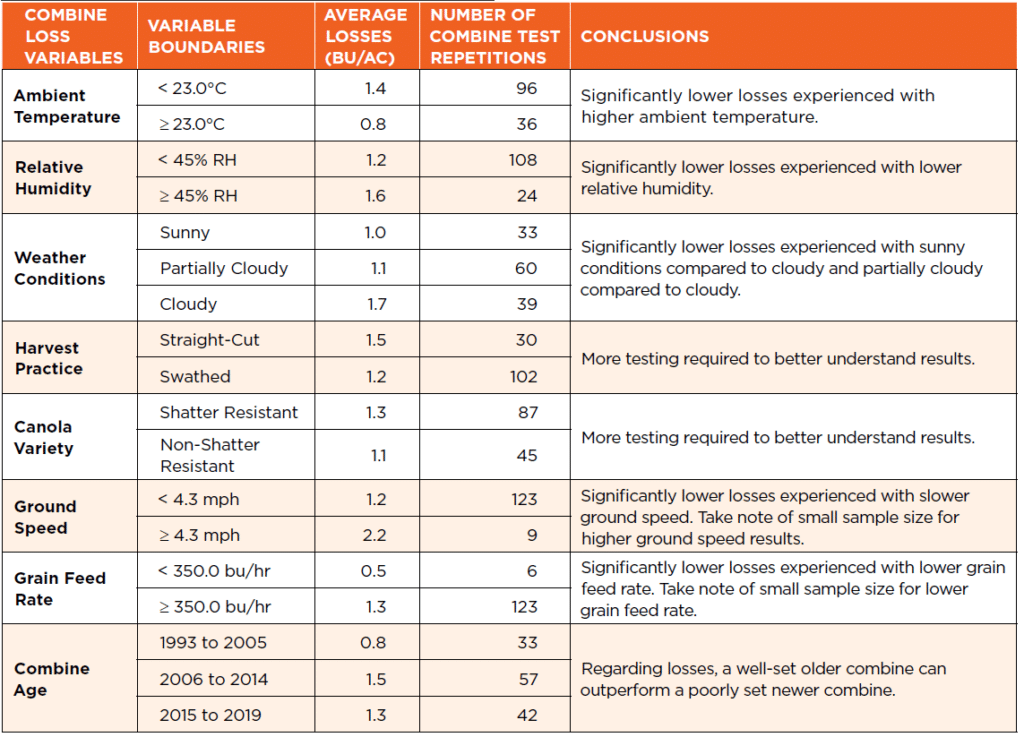Key Result
A combine yield loss survey of 50 combines across the Prairies in 2019 found that weather factors had significant influence on losses. This emphasizes the need to regularly adjust and test throughout the day and harvest season. Temperatures greater than 23°C, relative humidity less than 45 per cent, and low cloud cover all contributed to lower losses during this survey.
Project Summary
The objective of this project was to obtain a snapshot of the canola combine losses that producers are experiencing across Western Canada and to gain a better understanding of these losses by determining which variables are most likely to have an effect. A secondary goal was to continue to provide awareness to the seriousness of combine losses and to educate producers on methods for measuring their losses.
In-field testing occurred between August 22 and October 18, 2019. Prairie Agricultural Machinery Institute (PAMI) visited 31 producers across Alberta, Saskatchewan and Manitoba, and measured canola combine losses from 50 combines. Six combine manufacturers were represented during testing with a total of 40 different combine models.
Surveyors used drop pans provided by Bushel Plus and Schergain to measure the canola losses. The drop pans were attached underneath the combine and were dropped once the combine reached a steady state. The canola seed collected in the pans was separated from the chaff/straw and weighed. To ensure an accurate representation of producer’s losses, each combine loss test was repeated three times per combine, and producers were asked to run at their normal operating conditions during testing.
PAMI followed strict biosecurity procedures to prevent the transfer of crop contaminants, such as weed seeds, insects, and pathogens.
Of the 50 combines tested, 44 dropped their straw into windrows during the loss testing, while the remaining six spread their straw. Due to the reduced accuracy experienced when spreading straw (unpredictability of the distribution of grain throughout the discharged material), the results from those six tests were not included in the data analysis.
The variables investigated to determine their potential impact on combine losses are: harvest timing, ambient temperature, relative humidity (RH), weather conditions, wind conditions, harvest practices (straight-cut, swathed), grain moisture content, canola variety (shatter resistant, non-shatter resistant), ground speed, grain feed rate, combine settings, combine age, and separator hours.

Statistical analysis identified whether differences observed in the combine loss data were due to the measured variables listed above or due to random variability. Table 1 shows the variables that were found to have a significant impact on canola combine losses, along with the observed losses. For all other variables investigated (not included in table), no significant differences were observed in the data collected from the 2019 harvest season.
Of the analyzed results:
- The minimum loss measured was 0.2 bushels per acre (bu./ac.), which was 0.4 per cent of the producer’s yield.
- The maximum combine loss measured was 4.1 bu./ac., or 10.7 per cent of the producer’s yield.
- Average loss was 1.3 bu./ac., or 2.8 per cent of yield.
- At a canola price of $9.50/bu and average combine losses measured 1.3 bu/ac, the estimated financial losses are $12.35 per acre.

Furthermore, estimated collective financial losses experienced by the producers who participated in this study (using average combine losses measured of 1.3 bu/ac, a canola price of $9.50/bu and the 70,400 acres they seeded to canola) was $870,000.
This project highlights how important it is for producers to set their combines for current weather conditions and to use loss measurement as a way of verifying these settings. Producers also need to reassess combine losses as conditions change throughout the harvest day and season.
For more on how to measure harvest losses, see the CCC and PAMI Combine Seed Loss Guide and the Canola Calculator’s Harvest Loss tool. To learn how to reduce your harvest losses, check out the Combine Optimization Tool. For grower recommendations on harvest practices, visit the Canola Encyclopedia’s Harvest Management section.
Related research
- Read the earlier Canola direct-cut harvest system development study, investigating header losses and Investigation into converting a combine grain-loss signal into a grain-loss rate which investigates the feasibility of converting a combine’s loss sensor signal into a grain loss rate.
- Check out the subsequent Quantifying combine auto-adjusting capabilities in canola study, also carried out by PAMI.





